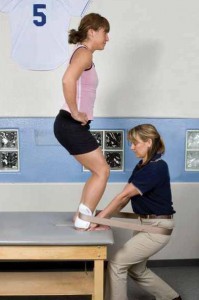Knee Pain While Climbing Stairs May Signal Early Osteoarthritis
 If you feel knee pain while going up and down the stairs, you may be experiencing the first symptoms of osteoarthritis.
If you feel knee pain while going up and down the stairs, you may be experiencing the first symptoms of osteoarthritis.
New research, published in the medical journal Arthritis Care & Research, found that climbing stairs appears to be the first weight-bearing activity that causes osteoarthritis pain. Researches say it’s important to detect the condition early because it can help increase the likelihood of people finding effective treatment.
“At present we have little concept of ‘early’ osteoarthritis and often only see people when they have significant longstanding pain and loss of function,” said Philip Conaghan, professor of musculoskeletal medicine in the University of Leeds School of Medicine. “This research is vital to understanding early symptoms of knee osteoarthritis. Knowing this will help us intervene earlier, perhaps leading to more effective ways of treating this very painful condition.”
Nearly 27 million Americans age 25 and older are diagnosed with osteoarthritis or, OA, according to published studies. Previous research reports that knee OA is the leading cause of functional limitation among older adults, making walking and climbing stairs difficult. About 80 percent of OA patients have some limitation in movement, with 11 percent of adults with knee OA needing assistance with personal care assistance, according to the National Health and Nutrition Examination Survey.
For the Leeds study, the team looked at the cases of 4,673 people who had, or were at high risk of, osteoarthritis. Participants completed annual surveys for up to seven years in order to help the researchers track the emergence of pain during different activities over a long-term period.
The study revealed that using stairs was the first weight-bearing task in which people noticed pain. After stairs, they reported feeling pain while walking, standing, lying or sitting and then finally when resting in bed.
Health professionals recommend walking 6,000 steps daily to help prevent the risk of developing mobility issues associated with osteoarthritis. Previous research has found that walking 6,000 or more steps per day may protect those with or at risk of knee of OA from developing problems, such as difficulty getting up from a chair and climbing stairs. That study was published in the American College of Rheumatology journal, Arthritis Care & Research.
Sources: University of Leeds, Arthritis Care & Research
+ Read about advanced techniques used in total joint replacement at Virginia Orthopaedic & Spine Specialists, which helps patients recover faster.
+ Find out how to improve your mobility and strength with the Arthritis Rehabilitation physical therapy program at Bon Secours In Motion.

